The Bad Deed that Robbed Compton Avenue of Its Most Iconic Church
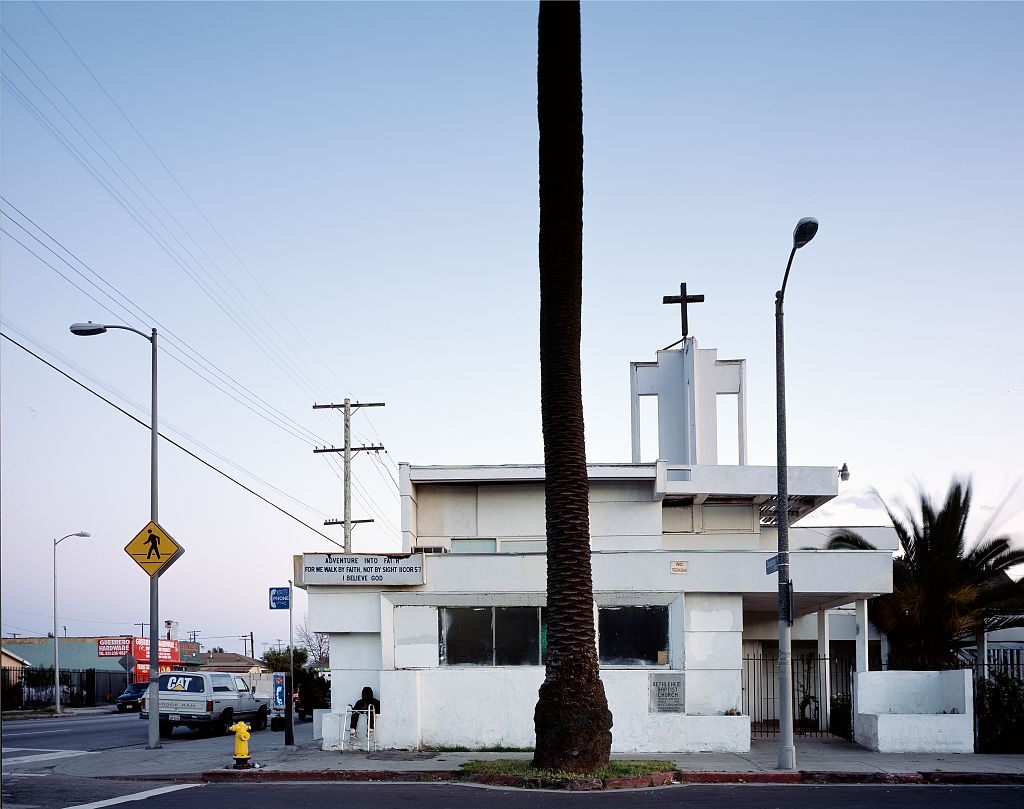
Bethlehem Baptist Church, photographed in 2005. (Photo: Library of Congress)
Pastor Melvin Ashley did not know the roughed-up, graffiti-scarred church on 49th and Compton Avenue, in Los Angeles, belonged to the city’s historic registry when he stumbled upon it late in 2013. Nor did he know that Vienna-born architect Rudolph Schindler, revered for his economical risk-taking, had designed it in 1944. He did know that the building stood in a part of South L.A. he lived in as a boy, when African-Americans were the main inhabitants and the area felt isolated from the rest of the city. He wanted a building in this neighborhood.
Once he did learn about Schindler, Pastor Ashley embraced the architect’s legacy as if God had placed it in his hands. Schindler aficionados started stopping by before he and his congregation, Faith Build International, finished moving in. A local designer, Brendan Ravenhill, donated chandeliers custom-made to suit the building’s easy, wide-open elegance, and Pastor Ashley gave interviews. Local press outlets described him and his congregation as “resurrecting” a forgotten treasure.
The day he spoke to a public television reporter, Pastor Ashley stood on the balcony above the altar as light shone in through high, narrow windows behind him. The church’s architect didn’t think like other people, Ashley said. “Schindler had this designed to get people to look up, to elevate their heads,” he continued, “elevate their consciousness.”
This church isn’t like the others on Compton, a street full of historic churches. Those buildings have steeples, stained glass windows or stairs leading up to prominent front doors. Schindler’s building sidesteps such norms–the main door, confusingly, is to the side. Brief accounts in scholarly books or newspapers tend to focus on the architecture, its horizontal lines or cruciform tower. Some accounts mention how Schindler crossed racial and economic barriers to build the church, or describe the area as poor and gang infested, but go no further.
This means the compelling story of spirituality, aspiration and greed that envelops the church remains unrecorded. There’s little written about the congregation that commissioned the architect, the building’s acquisition by a radical female minister, or its theft in a convoluted real estate fraud that generated a 1,500-page police file.
Rectifying this makes more sense than ever now, when for the first time, the Schindler church is on the market for a price only warranted by its monument status, and Faith Build International may be the last South L.A. congregation to afford to occupy it.
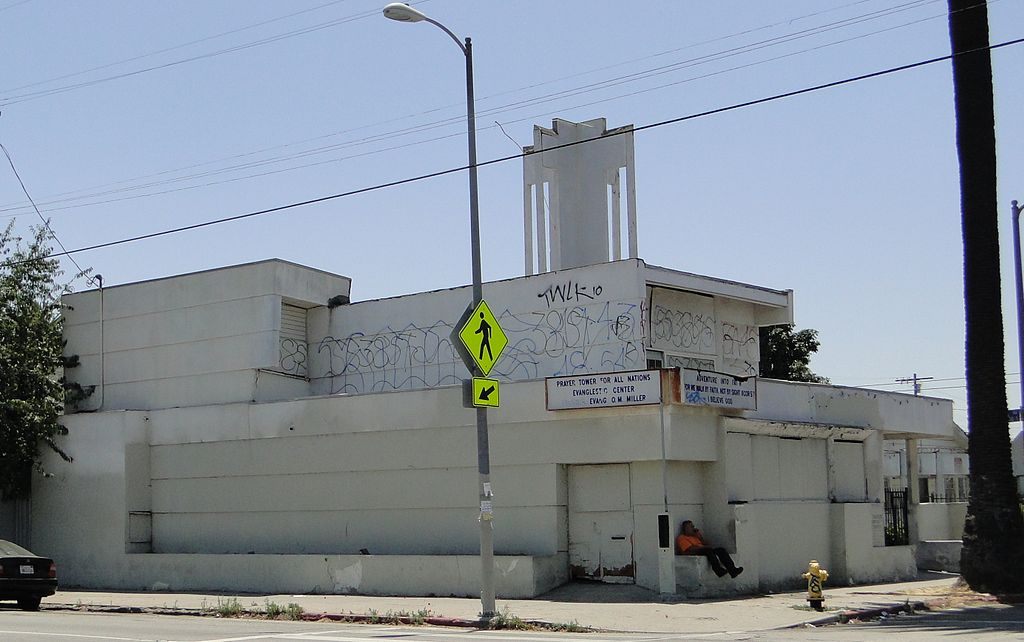
The church in 2011. (Photo: Cbl62/WikiCommons CC BY-SA 3.0)
The Sunday I visited, early in August 2014, Pastor Ashley preached from the book of Daniel. He had a small pulpit set up on the brown-painted floor and a larger one on the raised altar. Mainly, he stayed on the floor, moving back and forth as he spoke. He told the story of Nebuchadnezzar, king of Babylon, who threatened to kill any “wise men” who could not interpret a baffling dream. The way Pastor Ashley told it, it sounded like the king had intended to execute all Babylon’s people, which made young Daniel appear that much more valiant when he arrived to explain that Nebuchadnezzar had been dreaming about approaching famine.
Less than a year later, in March 2015, Pastor Ashley evoked different Bible characters. “It’s a David and Goliath story,” he told me over the phone. He and his congregation were David, the building’s owners Goliath. Faith Build International had initially made a $17,500 down payment on the church to lease it with the option to buy, Pastor Ashley explained. But the owners, a Beverly Hills-based investment group called Yamato Capital Fund, had surprised him by putting the church up for sale, at a price of $1.8 million. They listed it with an agency, Crosby Doe Associates, known for engineering the high-grossing sales of historic homes by architects like Frank Lloyd Wright and John Lautner. (Yamato Capital Fund did not respond to requests for comment.)
Pastor Ashley’s small, working-class congregation could not pay so steep a price, nor did they believe any one would do so for a frequently vandalized building in desperate need of repair.
By autumn 2015, the building’s price had dropped to $1.49 million, but Faith Build International was gone. Their website had disappeared; my phone calls went unreturned. “It’s been quite a while since Bethlehem Baptist Church, the only church designed by modernist master Rudolph Schindler, served its original purpose,” read a December post about the building on real estate news site Curbed L.A.
This is a trend with the church: describing it as if it has long been vacant, then discovered. A footnote in Paul Goldberg’s 2014 biography of architect Frank Gehry describes the church as “abandoned for years and nearly lost.” “[S]tood empty for decades,” asserted an article in the Architectural Review. There’s a story about a Getty Researcher riding by on his bike late in 2008 and “discovering” the derelict building. In 2009, after the church received its Historical-Cultural Monument status, newspaper reports cited the owner’s absence from the ceremony, implying the building had no concerned steward.
The legal papers associated with the church, in recent years, seem to tell a similar tale. The owner listed on the deed in 2009 was an Inland Empire-based plumber named Luis Niebla. He acquired the church for zero dollars in 2008, in a deed transfer from a certain Leroy Dowd. Dowd, who calls himself a bishop, would have been jailed for real estate fraud at that point. He had been in the business of scamming elderly women out of their property, then wiring millions to someone named Raymond, living in a Chicago penthouse.
The particular scam that put Dowd behind bars involved a woman named Ola Mae Miller, then 86 years old. In late 2006, Dowd fraudulently acquired her home in Claremont, California, as well as the Compton Avenue church that Miller, a prophetess and minister, purchased from its original owners circa 1976. She paid $39,000 for the celebrated Schindler-designed building, and held services there for nearly 30 years, almost until Dowd stole it from her.
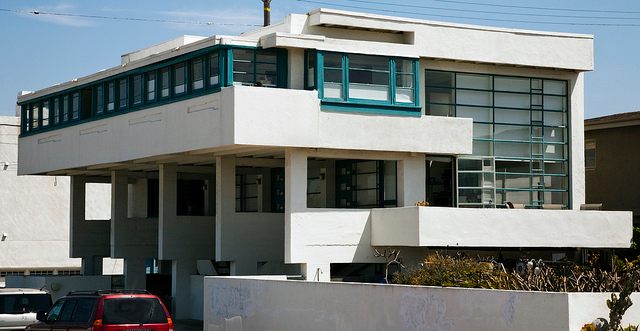
An iconic Schindler design: Lovell Beach House, completed in 1926. (Photo: John Fellner/flickr)
No one seems to know exactly how Schindler came to receive a commission from a working-class African-American congregation. The architect, who had wavy hair that fell past his ear and usually wore tunics or afghan cloaks, moved to Los Angeles in 1920 to finish a job by his idol and employer, Frank Lloyd Wright.
Schindler had already completed his most iconic buildings by the time he drew up plans for Bethlehem Baptist Church. The Kings Road House, where he lived with his wife Pauline, had outdoor sleeping porches and an office that made working seem austerely romantic. At the three-tiered Leland-Fitzpatrick House, on the crest of L.A.’s infamous Mulholland Drive, the basement is as well lighted as upstairs bedrooms.
Bethlehem Baptist, established in 1933, bought a building from the Compton German Methodists in 1934, around the time that African-Americans started moving into the South L.A. neighborhood known as Alameda. Architectural historian Esther McCoy, who worked for Schindler in 1944, describes the church in an unpublished essay. According to her, the congregation began saving money for a new building even before theirs burnt down in 1943. They had hoped to wait to commission an architect until after the war, when prices weren’t “sky high” in the words of Bethlehem Baptist’s choir director Rosa Lee Petche. Circumstances conspired against them.
“The first [architect] they talked to,” writes McCoy, “suggested a traditional church set squarely on the modest lot.” McCoy does not identify this first architect, but archives at UC Santa Barbara include a design by African-American architect James Garrott. His drawings show a building with a boxy steeple, arched windows and stucco exterior. It resembles the nearby building he designed for Mt. Zion Baptist in 1936. Maybe Garrott’s prices were high. Maybe there was some disagreement. Either way, somehow, Garrott disappeared and Schindler took the job.
Schindler rarely turned down projects if clients gave him the freedom he wanted. He also worked as his own contractor and could make small budgets go far. Possibly his thriftiness appealed to Bethlehem Baptist, but maybe his newness did too. “Some of the congregation had the idea that the church should reach toward the future as well as the past,” Reverend C.C. Brooks told McCoy in the late 1940s.
Schindler’s design comes right to the edge of Compton Avenue, a busy street then and now, leaving room for a yard in back. Long slabs of horizontal siding stretch across the building’s front without interruption. The siding widens from the base upward, leading the eye toward the flat roof, topped by a four-sided cross that looks almost like a 3-D paper cutout–a tasteful one. In the 1940s, the whole exterior was painted a brownish, mulberry hue.

The interior of the church with the Robert Barry text installation. (Photo: Courtesy the Artist and Thomas Solomon Art Advisory/ Photos by Joshua White/JW Pictures)
Inside, the floor of the L-shaped sanctuary slopes downward toward the altar, which sits in the building’s corner, like the tip of a diamond. The rest of the sanctuary surrounds the altar on both sides, angling outward toward lines of shoulder-high windows along the back walls. Schindler believed this design favored people’s desire to participate over any idea of authority. “[P]eople are needed to complete the picture,” he said, after speaking derisively of traditional sanctuaries with their forward-facing pews.
The choir, which at one point included R&B chart-topper Roy Milton, had to climb up a set of outside stairs to reach the balcony. Schindler frequently designed buildings in which indoor-outdoor movement was seamless but also requisite.
By the time McCoy wrote about the church, the choir had stopped using the balcony. They sang on the ground floor, closer to their fellow congregants. “It took people a while to get used to [the building],” Revered Brooks told her. “Now they’ve lost all sense of it being different.” He particularly liked the ceiling height. “You’ll never get high blood pressure the way you would in a low-ceilinged church,” he said.
Documents archived at Santa Barbara, including letters from Schindler’s lawyer, suggest Schindler had not received full payment for the building at the time of his death in 1953. Letters also suggest he occasionally volunteered his services when it seemed Bethlehem Baptist was struggling to maintain the building.
The original congregation stayed on into the 1970s, when a liquor store opened across the street and the neighborhood’s demographics began to shift, becoming predominately Hispanic. They moved west, to a larger, more conventional building on Normandie Avenue and West 74th Street. Neighbors and scholars I talked to kept telling me the original congregation hardly existed–a woman who lived next to the Schindler church said she doubted the original congregation was still intact, citing how quickly smaller, poorer congregations can disappear.
The day I visited the worn Normandie building, Pastor Vernon Washington, a tall man with a gentle face, looked tired. He had spent the night at the hospital by his dying mother Dorothy’s bedside. His brother’s body was sitting in a funeral home on San Pedro Street. But his mother, he told me, had joined Bethlehem Baptist in 1943. He had been a child in the Schindler church–so had Sister Morgan, his youngest aunt–but he would have to tell me more later.
“Right now, I have to focus on my Creator,” he said, before giving an unusually short sermon that he described as “like an airplane taking off from a runway.”
Later, Pastor Washington, who has been the minister for 15 years and seen the church grow and decline over nearly seven decades, would describe how large the original building seemed to him as a boy. He would also recall a moment at the height of the Civil Rights movement when the congregation stopped meeting in the sanctuary, holding services in the rec hall or outside. Had there been another fire? He’s not certain.
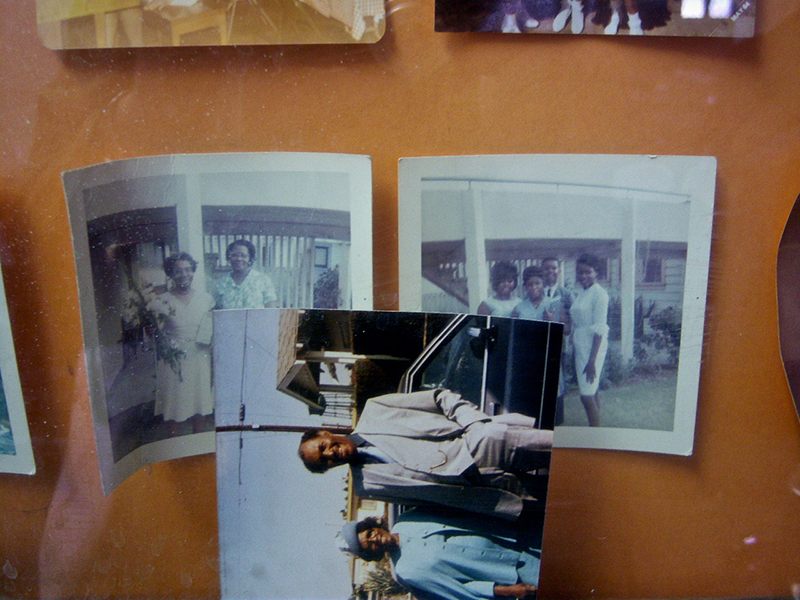
The photos are taken against the Schindler-designed columns that lined the original building’s back yard. (Photo: Catherine Wagley)
Polaroids on a glass-encased bulletin board above the water fountain in Bethlehem Baptist’s current foyer showed couples and groups of girls posed in front of the Schindler-designed columns that lined the building’s back yard. These would have been taken in the late 1960s or early 1970s, around the time Minister Ola Mae Miller, the Schindler church’s second owner, went looking for a new home.
In the little written about the church’s inhabitants, Minister Miller is occasionally described as O.M. Miller, leaving her gender vague. The few online traces of her come in the property records for the church and her Claremont home, both of which start switching hands at surprising rates around 2006. Her shaky signature releases them to Leroy Dowd, who then transfers the deed to her home to someone named Bessie Moore, and the deed to the church to an LLC called Treal, run by a broker named Alex Trevino. Trevino transfers the deed back to Dowd in May 2008, after which Dowd transfers the deed to the plumber, Luis Niebla.
Miller is also referred to by name in a 10-minute video released in 2014, which originally appeared on the now vanished “Project Leroy Dowd” website. Background music plays softly while 76-year-old Dowd, four years out of jail, discusses “the worst situation any human could ever encounter.” He speaks in a naïve, confused voice, his eyes wide throughout, and says he met Ola Mae Miller, a former beautician, in 1978. Then they became the best of friends, according to glowing text that floats across the screen. He goes on to describe being framed for stealing Miller’s home by an unnamed real estate agent who “did many things in the scheme of real estate” and “had concoct [sic] some kind of idea with whatever.” The whole story floats by in a stream of vague descriptions, as if Dowd is himself too baffled to pin down details.
“Well, I hate to get emotional, but think about what I’ve gone through,” he says, near the video’s end, after more glowing text describes two heart attacks he suffered behind bars.
“I would shake him good,” is apparently what the aging Miller said in 2007, when she learned that Dowd, a man she did indeed meet when he frequented her church circa 1978, had scammed her out of her property.
In 1978, Miller would have been almost 60. She had been born in October 1921 near Houston, where she finished the 8th grade before going to work. She began prophesying as a girl, her church secretary, Altonette Carter, told me, the day we first talked on the phone, Carter sitting in her car outside the house she’d moved to in Marietta, Texas, to care for her aging mother. Carter said she met Miller, whom she still calls “mother,” in 1973, and they stayed close for the rest of Miller’s life.
Ola Mae Miller came of age in the Holiness movement and belonged to the Church of God in Christ, which did not condone female preachers. She would have to break with her denomination if she wanted to lead a congregation, and, at the start of the 1970s, she did. She called her new church Prayer Tower for All Nations, saying God gave her that name. Bishop S.M. Crouch, her long-time pastor in the Holiness tradition, decided she should tack on “Evangelistic Center.” She had always been an evangelist, he pointed out, and the addition of “center” would give the title a ring of authority.
First, she leased a building on Hooper and 21st. People started coming from as far as San Bernardino or Victorville when they heard she could put her foot on someone’s stomach and force demons out. She soon needed more space. So she moved to Inglewood.
When Miller put a bid on the Schindler church, her offer was the lowest, remembered Carter. They were in Sunday service one afternoon soon after, and a man in the congregation began prophesying her bid would win out. The implication is that God wanted her to have the building, and while there’s no paper record to back this up, that a woman breaking with church pecking order would acquire a building that challenged hierarchical norms does seem serendipitous, if not miraculous.
The Prayer Tower for All Nations Evangelistic Center moved into the building on Compton by 1977. “We always said the building was built unusual,” said Carter, citing the flat roof as particularly baffling, even in a city where rain was rare. It was years before the roof started leaking, however. “Prior to that it lasted us for a while.” But when I told her what Schindler said about the design–that the modern architecture took into account the social aspect in ways traditional architecture didn’t, that the L-shape encouraged freedom of movement–she said, “Oh yes, it did all that. We ran and shouted and got loose and prayed in there.”
Sometime in the late 1970s, Miller, who never liked the raised platform for the altar, had a vision. She enlisted a younger man in the congregation to cut through the stucco (“You always do come up with the hard way to do things,” he apparently teased her), so that there would be a half-circle opening in front of the platform with stairs going up and down. This way, instead of walking around to the side of the sanctuary and behind a wall to get to the pulpit, she could move up and down easily.
The Prayer Tower for All Nations painted the sanctuary light blue in the 1980s, and Miller ordered all-blue pews. On special occasions, she sewed uniforms–once an all white dress with a red sash–for the women in the congregation to wear. Services lasted all day on Sundays, and, during peak years, were also held on Tuesdays, Thursdays and Saturdays. Gawkers routinely arrived from Europe or other parts of L.A. to sit quietly in back and observe the architecture.

Photos on the church’s bulletin board. (Photo: Catherine Wagley)
If a few congregants met to clean the building, tend the garden of collard greens they’d planted in the yard or for choir practice, they might end up having service, “if the spirit got to moving.” Carter cited the nights they slept in the back house at the end of the sidewalk, where the kitchen and office were. “We spent many nights in there praying. I saw miracles, miracles, miracles.” There was the time Brother Ruben had a toothache healed, the time two sisters on welfare got jobs, the time a dollar materialized, rolling right out of a broke brother’s shirt.
In the 1990s, Prayer Tower congregants installed a tall iron fence to keep the building safe from the growing number of vandals who tagged it. Sometime around then, a stroke slowed Miller down. She would drag her right side slightly for the rest of her life, walk with a cane and gradually lose some of her mental sharpness. She had moved to Claremont, east of Los Angeles, because God told her to live near rolling hills, and she had set up a satellite congregation in nearby Ontario. But she would continue driving the 40 minutes to Los Angeles multiple times a week, into the early 2000s. At that point, the congregation was small enough that they met in the back house rather than the sanctuary.
They had all but stopped meeting by November 2007, when Carter received a call from Miller.
“I want you to have my furniture,” said Miller. “Put it in storage.”
“Where are you going?” asked Carter. “I don’t know,” Miller responded.
Carter had recently received another odd call, this one from Brother Ruben Robins, who checked up on the church frequently. The winos, many of whom had been loitering outside the building for years, told Robins about strange late-night comings and goings. One night a man jumped the gate, cops came and then a second man arrived, sending the cops away. The winos recognized the second man, who fit Dowd’s description, from Sunday services.
Carter started digging through paperwork, and found the transferred deeds, of which Miller had no memory. Carter filed an elder abuse report in the City of Claremont in early 2008, when Miller’s home had already gone into foreclosure.
Sergeant David De Metz remembers the Ola Mae Miller saga taking over his life for five to six months. He stills has 1,500 pages on file from the case, which he called “a story in itself.”
This was his inauguration into real estate fraud’s convoluted nuances. He recalls dashing down to Norwalk, California, to stop Miller’s house from being auctioned on County Hall steps and driving through South Los Angeles to find all the properties that Dowd had mysteriously acquired over the past two decades.
Bessie Moore, who had an income of only $48,000, had been the straw buyer for Ola Mae Miller’s house. She falsified her income, probably with Dowd’s help, and acquired an IndyMac loan for $800,000, most of which she paid to Dowd, who then signed the deed to Miller’s Claremont home over to her. A few years earlier, she had bought another home from Dowd that belonged to a deceased woman named Rebecca Mae Ford. “Bishop Dowd, what have you done to me?” a distraught-sounding Moore said in her statement to police, before asking for an attorney.
Real estate agent Alex Trevino, who still runs Trevino Properties in Los Angeles, brokered the deal between Dowd and Moore, and also, for a little less than a year, became legal owner of the Schindler church. His was the last house De Metz and his team searched. “I literally went looking for the money,” said De Metz, recalling climbing around in an attic.
They found no money in Trevino’s home, but did find cryptic handwritten notes about a Chicago church called Citadel of Hope with a bad reputation for preying on the elderly. The notes, recounts De Metz, said “Bishop saying mafia involved,” and mentioned $17 million being wired to a certain Raymond Wilson. Wilson lived in Chicago, in a penthouse, and had indeed been receiving tens of millions in money transfers.
DeMetz arrested Dowd, Trevino and Moore in June of 2008, though he believed more people may have been involved. He also alerted Chicago authorities about Wilson and the Citadel of Hope. Dowd spent a year in prison for charges that included check fraud and grand theft. Trevino and Moore got off with time served. (In 2012, after Dowd’s release, an elderly woman in Lynwood, south of L.A., lost her home. She had been in a nursing home and barely cognizant when she signed her property over to Dowd. His straw buyer in this case was an LAPD officer named Darcy Greenfield, who had a real estate business on the side and was charged in 2011 of ten counts of wire fraud.)
“He’s a true crook,” said De Metz of Dowd. “He’s smart and was probably getting away with this for a long time.” De Metz legally returned Miller’s home to her in 2010. The church, outside of his jurisdiction, was repossessed by the city for back taxes. Yamato Capital Fund paid $210,000 when they bought it in 2012.
Carter remembers the new owners calling her and asking if the Prayer Tower might want to lease the building. “You got something that already belonged to us,” she said. Of course they didn’t want to lease it.
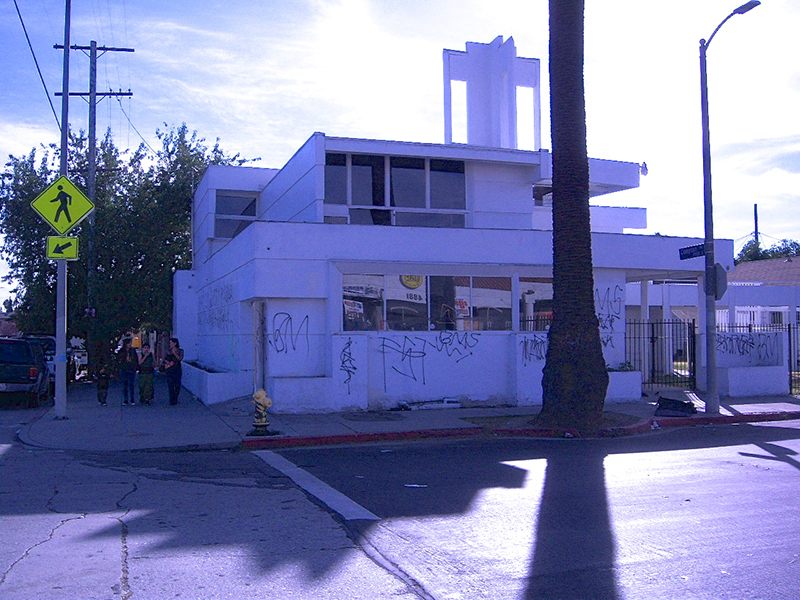
The church with graffiti, December 2015. (Photo: Catherine Wagley)
Artist Linda Cabrera was finishing high school when her family moved into the house across the alley from the church in 2009. At that point, it did look abandoned. Rats infested the alley. After Cabrera enrolled at UC Santa Barbara and became interested in architecture, she stumbled upon an image of the church and realized her family lived beside a historic Rudolph Schindler building.
She was at home in 2014, when a group of laborers arrived to fix up the church. They had given themselves less than a week to complete the job. “How will you finish?” asked Cabrera. “With God’s help,” one of laborers told her.
Cabrera emailed me late one Friday night in early December. She had been visiting her family and had just watched a group of men vandalize the church with black spray paint. Two stood watch at the corner; while one waited in a getaway car.
“I wanted to go and ask them why,” she wrote, “but as ridiculous as it may sound I did not for the fear of getting shot.”
I drove by two days later, to see the black marks sloppily spray-painted on the building’s front and side. Inside, art advisor Tom Solomon was sitting at a desk with his assistant. Since November 1, Solomon had been hosting an exhibition in the sanctuary by Robert Barry, the New York-based conceptual artist.
When Solomon first visited the building with his friend, Crosby Doe realtor Ilana Gafni, he imagined Barry’s minimalist lettering filling the now-empty space. The owners agreed to a short-lived exhibition, which Solomon advertised with a gorgeous full page spread in the magazine ArtForum.

Words written in white vinyl cover the walls as part of Robert Barry’s installation. (Photo: Courtesy the Artist and Thomas Solomon Art Advisory/ Photos by Joshua White/JW Pictures)
Words in white shimmering vinyl angled across the white walls. The word “Absurd” was right above the railroad-tie cross. “Without” was upside down, high on the Compton-facing wall. The sunlight and time of day affected the legibility of the words, which went every which way, and emphasized the egalitarian nature of the design. I climbed up to the balcony, to look down, and still didn’t feel like I had a more privileged perspective than I did on the ground floor. It was all angles and light, no hierarchy.
Solomon cited the various museum curators and researchers, from the Los Angeles County Museum and the Getty, who had stopped by since the show opened. Architects and historians had also visited. He hoped a foundation or museum might buy it, and turn it into a community space. Certainly, at $1.49 million, a congregation from the neighborhood isn’t likely to occupy it again.
Ola Mae Miller died at age 93 in May 2014, only a month after Melvin Ashley’s Faith Build International held their first service. Miller had visited the church one last time, on a rainy day early in 2008. Carter and Brother Robins drove her there, planning to have a final prayer service all together. Miller refused to get out of the car, saying she was tired and couldn’t manage the walk to the door. Carter suspected she didn’t want to see the church in such a sad state of disrepair.
Before she found the building in the mid-1970s, one of Miller’s parishioners had prophesied: “God says he’s going to give you a church that’s never been anything but a church.” For her, it had fulfilled a vision.


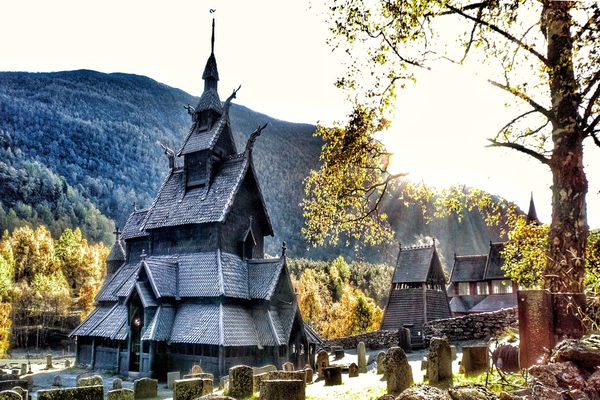
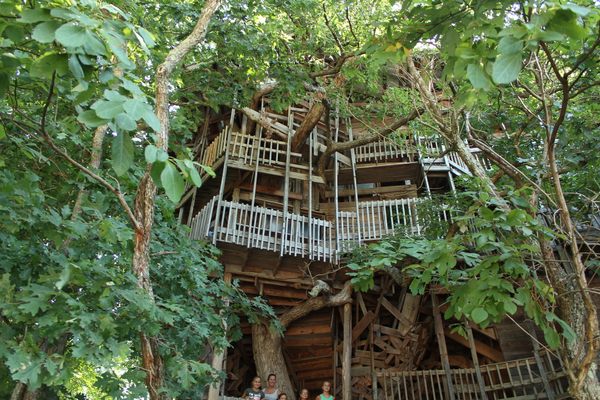
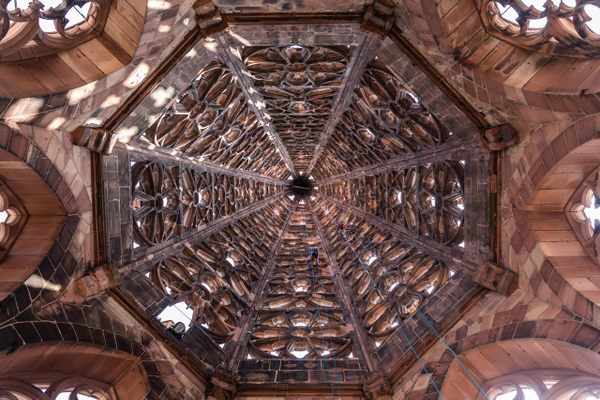















Follow us on Twitter to get the latest on the world's hidden wonders.
Like us on Facebook to get the latest on the world's hidden wonders.
Follow us on Twitter Like us on Facebook